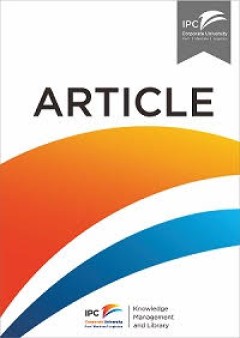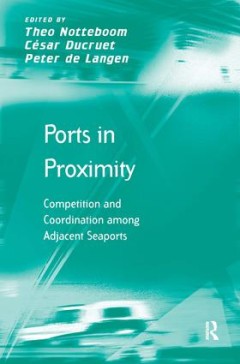Ditapis dengan

Strategic beliefs of port authorities
- Edisi
- Vol. 37 Issue: 4, pp. 412-441
- ISBN/ISSN
- 1464-5327
- Deskripsi Fisik
- -
- Judul Seri
- Transport Reviews
- No. Panggil
- ATC PO LUG s
- Edisi
- Vol. 37 Issue: 4, pp. 412-441
- ISBN/ISSN
- 1464-5327
- Deskripsi Fisik
- -
- Judul Seri
- Transport Reviews
- No. Panggil
- ATC PO LUG s

Towards an ‘inland terminal centred’ value proposition
The two main value propositions in international container transport are ‘port-to-port’ services and ‘door-to-door’ services. In port-to-port services, buyers ‘just’ purchase maritime transport from a shipping line. Door-to-door services comprise the total transport chain and include land-based transport. Carriers as well as forwarders offer these door-to-door services. In this pape…
- Edisi
- Vol. 42, No. 5, 499
- ISBN/ISSN
- 1464-5254
- Deskripsi Fisik
- 18 p.
- Judul Seri
- Maritime Policy & Management The flagship journal of international shipping and port research
- No. Panggil
- ATC LO BER t

A new approach to granting terminal concessions: the case of the Rotterdam Wo…
This paper describes in detail the award process of the concession for a large container terminal in the port of Rotterdam. This process can be termed competitive bidding, and differs from a tender because of the frequent interaction between the Port of Rotterdam Authority and the candidates. The competitive bidding process is a potentially attractive form in which to grant concessions, if ther…
- Edisi
- VOL. 39, NO. 1, 79–90
- ISBN/ISSN
- 1464–5254
- Deskripsi Fisik
- 14p
- Judul Seri
- Maritime Policy & Management: The flagship journal of international shipping and port research
- No. Panggil
- ATC LO LAN a

Seaports and the structural implications of the economic crisis
The 2008 credit crunch and the subsequent economic crisis ended a period that lasted over two decades wherein international seaports around the globe experienced double-digit volume increases. This chapter provides an analysis of the structural effects that the crisis has on seaports, focusing mostly on developments in Europe. It does so via an examination of (a) the crisis implication for each…
- Edisi
- -
- ISBN/ISSN
- 0739-8859
- Deskripsi Fisik
- 9 p.
- Judul Seri
- Research in Transportation Economics
- No. Panggil
- ATC PO LIS s

The trajectory of project management: why EPOS is important
This paper welcomes the pluralistic knowledge base represented by EPOS, it being particularly appropriate to our efforts to understand the knowledge needed to manage projects and programs effectively. The paper charts the advances in our thinking about project and program management from the early a-theoretic NASA/DoE days, through a later period reflecting our growing recognition of the import…
- Edisi
- Vol. 3, No. 2
- ISBN/ISSN
- -
- Deskripsi Fisik
- 6 p .
- Judul Seri
- Engineering Project Organization Journal
- No. Panggil
- ATC MG MOR t

Collective action regimes in seaport clusters : the case of the lower Mississ…
This paper analyses the competitiveness of the Lower Mississippi seaport from a cluster perspective, discussing the importance of local governance and collective action regimes for the competitiveness of the cluster. The case study of the Lower Mississippi port cluster shows that collective action regimes are relatively poorly developed in this cluster, compared with the seaport cluster of Rott…
- Edisi
- -
- ISBN/ISSN
- -
- Deskripsi Fisik
- 14 p .
- Judul Seri
- -
- No. Panggil
- ATC PO LAN c

Chapter 5 : goverance structures of port authorities in Netherlands
This chapter describes the governance structures of the port authorities of the major Dutch seaports. This description is based on a framework to assess the fit between the environment, governance model, strategy and capabilities of the port authority. Changes in the port environment have triggered changes in the governance model and strategy of seaports. For the three major Dutch seaports, reg…
- Edisi
- Volume 17, 109–137
- ISBN/ISSN
- 0739-8859
- Deskripsi Fisik
- 26 p.
- Judul Seri
- Chapter 5
- No. Panggil
- ATC PO LAN c

Assessing the intermodal value proposition of shipping lines: attitudes of sh…
Shipping lines generally offer their clients two main value propositions: portto-port and door-to-door transport. In addition, some shipping lines offer a third value proposition in the form of transport up to inland terminals (ILTs). This third value proposition combines maritime and inland transport and is offered to two types of customers: shippers and forwarders. These two customer groups h…
- Edisi
- -
- ISBN/ISSN
- 1479-2931
- Deskripsi Fisik
- 20 p.
- Judul Seri
- -
- No. Panggil
- ATC PO BER a

PORTS IN PROXIMITY
- Edisi
- -
- ISBN/ISSN
- 978-0-7546-9385-7
- Deskripsi Fisik
- xxvi, 332 p
- Judul Seri
- -
- No. Panggil
- TXT PO NOT p
- Edisi
- -
- ISBN/ISSN
- 978-0-7546-9385-7
- Deskripsi Fisik
- xxvi, 332 p
- Judul Seri
- -
- No. Panggil
- TXT PO NOT p

Port competition and selection in contestable hinterlands; the case of Austria
This paper deals with port competition and port selection for cargo to/from Austria. Austria is located centrally in Europe and seaports in at least five countries are used for imports and exports. Changes of market shares over time of different ports serving Austria are analysed. Switching of cargo between ports does take place, but friction prevents instantaneous switching. Consequently, it t…
- Edisi
- -
- ISBN/ISSN
- -
- Deskripsi Fisik
- 14 p .
- Judul Seri
- -
- No. Panggil
- ATC PO LAN p

Chapter 20 stakeholders, conflicting interets and governance in port clusters
In this chapter, an analysis is made of conflicting interests in seaports. Such conflicting interests are relevant since various stakeholders influence port development and have different goals. Based on an overview of the interests of different stakeholders, five conflicts of interests that are relevant in most seaports are identified. Each of these is briefly discussed and the concept …
- Edisi
- Volume 17, 457–477
- ISBN/ISSN
- 0739-8859
- Deskripsi Fisik
- 21 P.
- Judul Seri
- -
- No. Panggil
- ATC PO LAN c

Logistics sophistication, manufacturing segments and the choice of logistics …
To investigate the relationship between the choice of integrated or functional logistics providers by Brazilian shippers and: the type of their manufacturing process structure, and the level of sophistication of their logistics function, as well as the impact on that choice of possible interactions between these two characteristics of the shippers.
- Edisi
- Vol. 27 No. 5, 2007
- ISBN/ISSN
- -
- Deskripsi Fisik
- 20 p.
- Judul Seri
- International Journal of Operations & Production Management
- No. Panggil
- ATC LO FER l
 Karya Umum
Karya Umum  Filsafat
Filsafat  Agama
Agama  Ilmu-ilmu Sosial
Ilmu-ilmu Sosial  Bahasa
Bahasa  Ilmu-ilmu Murni
Ilmu-ilmu Murni  Ilmu-ilmu Terapan
Ilmu-ilmu Terapan  Kesenian, Hiburan, dan Olahraga
Kesenian, Hiburan, dan Olahraga  Kesusastraan
Kesusastraan  Geografi dan Sejarah
Geografi dan Sejarah